Chapter 2: Quests Five through Eight
THE INTERLUDE: THE END OF TIME
The end of time is important--although how it�s important will be explained later in detail. Basically for now we can recognize it as the close of the first �chapter� of the Tragedy, and the break before the beginning of the second chapter. Again, though, we�ll cover more about this establishment of rhythm later.
Quest 5 - The Rational Use of Magic
Stat of the Quest:About 1 in every 10 non-boss enemies in Chrono Trigger are strictly resistant to physical attacks. Strangely, though, about 75% of those resistant enemies come in the Tragedy of the Entity. For bosses, the reverse of that is true. Of the strictly physically-resistant bosses, 75% of them come in the Comedy of the Sages.
Medina village begins a key deception in the game: the red herring on the origin of Lavos. If you�ve been reading the first four quest synopses, you�ll note it�s not the game�s first deception--not by a long shot. Nevertheless it�s important that the game continually deceives the player in order to keep him or her off balance--and it certainly happens often.
The NPC sociology reflects this clearly. (If you want to know what NPC sociology is, and why it�s important, see here.) The second-most common category for NPC speech in the game is direction, for reasons we�ll get into later. In Medina Village, however, there is only one bit of direction-chatter in all 17 residents; it�s usually 1 in 4! Additionally, the rate of event-chatter is 15% higher than normal. That�s a little bit artificial, isn�t it? The mystics seem to have spent the past 400 years dwelling on a single unfulfilled event--not even understanding what was supposed to occur. But there�s no way a new player can know that yet. The designers are setting them up to be surprised.
The Heckran Cave dungeon serves as a lesson in how to use the magic the player has just acquired. The entire dungeon is filled with tech-only, and, specifically magic-only, monsters. Fire Whirl will work just fine because it�s still technically magical, but most of the enemies are configured so as to make this impractical. The area-attack and double tech lesson is over; now it�s time to learn how to use--and more importantly how to ration--single-target attacks. To that end, most enemies will fall quickly to magic. Marle and Lucca�s first-level elemental spells have damage floors around 120, which will instantly kill any enemy in the cave. If Crono hasn�t reached level 12 or isn�t using the Red Katana, his damage floor might start in the 80 damage range, which would mean he can�t kill the Cave Bat or Jinn Bottle enemies. Properly leveled and equipped, however, all party members should never have to cast more than once per enemy. Additionally, Robo�s Laser Spin has a damage floor around 88, which would end many battles all at once. This is to say that there is a lesson to be learned, but it�s an easy lesson.
The Heckran is much like the other monsters in the cavern, weak only against magical attacks. The Hecrkan also brings back the design features of the Guardian: periodic phases and severe counterattacks. The Heckran enters a short, periodic counterattack phase (�Go ahead and attack, I dare ya!�). It would be possible to heal through these attacks with Aura Whirl, if it were not for the fact that this would consume all the MP that the party needs to cast spells to defeat the Heckran. In the end, it�s simpler to wait. Interestingly, this is the only point in the game where the player will really wait and do nothing in a battle.
After the battle, the Heckran feeds the player a Lavos-flavored red herring, and the party has their next quest.
Quest 6 - A Mountain of Things to Do
Stat of the Quest:NPC Sociology Breakdown!
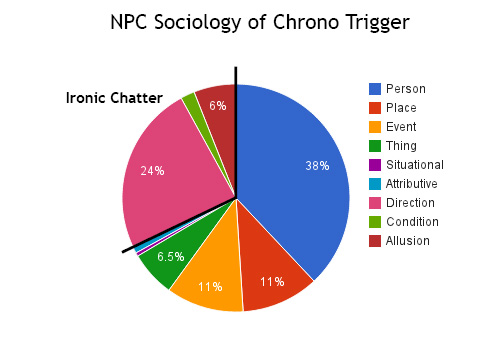
Note that this counts the first dialogue spoken by NPCs, or the first new dialogue they say during a new quest. There are very few reaction dialogues graphed, because almost all of the reaction dialogue in the game happens after you complete a quest. Most NPCs local to that quest will give you a reaction dialogue right after the quest, but will lose that dialogue when the next quest in their area/era starts.
Quest 6 is the biggest quest so far and marks the beginning of the only time in the first game where there is a specific, larger meta-quest other than �stop Lavos�. That quest is to find and defeat Magus so that Lavos is conveniently edited out of history. There is a macguffin involved--the Masamune--and this �chapter� will take three more quests to complete.The whole thing is another attempt to deceive the player with various forms of pacing. In this case, the designers were confronted with a problem: how do we make the game feel like it�s ramping up towards a (false) climax without just throwing over-long dungeons at the player? It�s too early for really long dungeons, and Chrono Trigger is too carefully crafted for a sharp spike in difficulty. The first solution to all this was to ramp up exploration activities: non combat quests, talking to NPCs to find treasures and quest locations, searching shops for gear, trying to track people down, etc. The second solution was to create a dungeon that feels longer and more challenging (at first glance) than it really is.
The exploration activities start the player with a mini-quest, to bring supplies and reinforce Zenan Bridge and finish with a two-town manhunt for Frog and Tata. Having probably never been there, the player has to figure out that the action is happening at Zenan Bridge, then has to talk to numerous people at the bridge and in the castle to figure out that it�s the Chef who is the object of your current task. It�s hardly spelled out. There�s a boss in the middle of all of this; he�s not terribly interesting from a design point of view, aside from being the first incidence of conspicuous elemental defenses. After the fight the player gets even more exploration. Instead of having one new village to explore per dungeon (as has been the norm) there are two! Dorino village exists for the purpose of making it obvious that Mt Denadoro is the next dungeon. It doesn�t do an amazing job of this, however. You can count the major flaws in Chrono Trigger on two hands, but Dorino is one of them. Two NPCs in Dorino will inform the player of the Masamune�s supposed location �nearby�, and that the �hero� Tata is after it. All of the relevant NPCs in Porre will speak about Tata, but not his location.
The NPCs in Dorino and Porre do a better job implying the false climax that will come of Magus� Castle. There�s an interesting spike in expansion - event chatter here; we�re finally getting some background on Magus, Frog and Cyrus, and what happened to set this all in motion. (The average rate for event chatter across the whole game is 11%, whereas in Dorino it�s just above 33%.) Very few of those bits of chatter have any directions in them, but they do serve to make it seem like Magus will be at the center of the main quest. Little is mentioned about Magus at any time before this (or after). Additionally, having two towns and all these new NPCs makes the game seem big enough that it might be entering its �pure dungeon phase,� where exploration gives way to dungeon after dungeon. Players who had been playing other Squaresoft RPGs in the 90s would have known that four or five towns introduced by the main plot (Guardia Village, Truce Village, Medina Village, Trann Dome, Arris Dome) were too few to be a complete game. Seven villages with dozens more people makes the game seem fuller than the 10 or so hours of length it has actually been.
Denadoro is the biggest dungeon so far (although its size is quite deceptive) and, for Chrono Trigger, it is unusual. Dungeons should get bigger and more challenging as the game goes on; no player will be surprised about that. What is unusual about the dungeon is its structure. So far the big dungeons have been divided into two distinct parts. The Cathedral had a save point in the middle. Guardia Prison did not, but it was small (if confusing). Lab 16 and the Info Center had a world map segment and a save point in the middle, which was a little odd but still divided the dungeon into two neat parts. The Factory Ruins had an obvious division between the left and right elevators, with a save point in the second section. The Heckran Cave was short enough that, like Guardia Prison, it didn�t need division.
Mt Denadoro is a long dungeon, but the only save point within is located one fight before the boss. This is no accident; like everything else in the game it is the designers� way of playing with pacing. In truth, Denadoro has fewer monsters and fewer total enemies than the Cathedral. It feels a lot longer though, and almost certainly takes longer. Part of that feeling of length comes from that lack of a dividing save point. Another part of the length is the battles with Ogans, an enemy with a new design feature: triggered vulnerability.
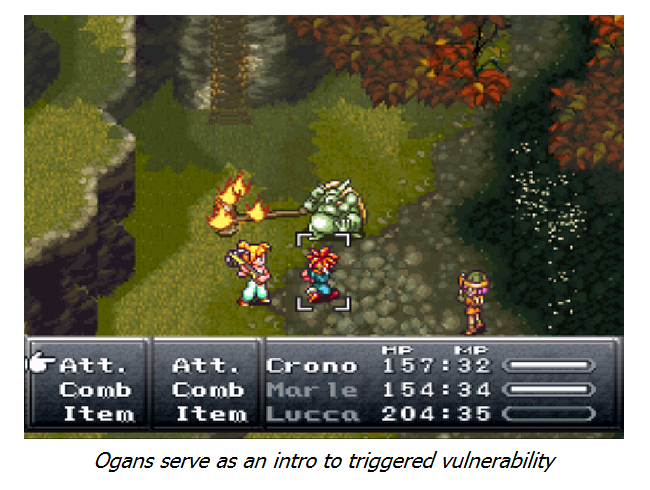
Triggered vulnerability means that an enemy is strongly resistant to normal damage until it is hit with a specific attack. In this case, the attack is fire from Lucca. Triggered vulnerability works well toward making battles a little bit harder and longer without really being dangerous. Many of the Ogans that feature this triggered vulnerability appear in a sequence of battles that occur on a ridge. There are several fights in a row, during which time the player can only heal in battle. Coming into this sequence with low MP will make things difficult; that�s part of the point, though. It�s not that many enemies, but it feels like it is, on the first trip through.
That long sequence of battles contains the essence of the dungeon and really the essence of quest 6 as a whole. The quest is designed to feel longer, more challenging, and more climactic than it really is. The late-coming save point, the slow grind through enemies with triggered vulnerability, the sequence of battles--they all contribute to this deception in the pacing of the game. The boss certainly contributes to this effect.
The boss of Denadoro is far and away the most difficult one faced yet. In fact, there are two bosses. The first form of Masa and Mune is just a way of fooling players into thinking that they�re done after a moderately difficult fight. (The brothers are capable of inflicting the very tedious Chaos effect.) Of course, it isn�t over at all. MasaMune doesn�t do anything really special, however, from a game design point of view, except surprise the player with more than they thought they were getting, and having more HP and doing more damage than ever before.
The the takeaway message, in a sense, is that it should give the players the impression that the game is mounting to something big, even though it�s going to be a false climax. To that end, the designers pulled out an awful lot of design tricks.
Quest 7 - MacGuffin Collection, Prehistorically
Stat of the Quest: This quest encourages the player to spend time hunting for barter items, so as to break the tension before Magus Castle. One way it accomplishes this is by bumping up the power of equipment, as you can see in this charts:
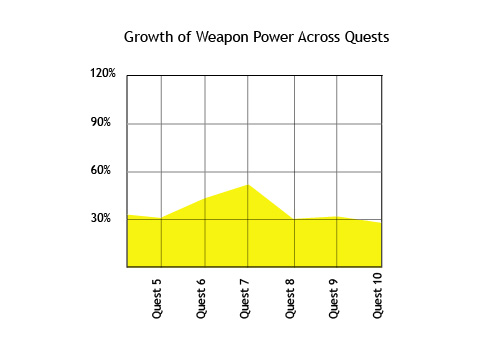
The seventh quest presents another interesting quirk of pacing. Quest 7�s most important feature is that it�s short and offers a bit more freedom than usual--a kind of lull in the rising action of the game, as if the game were taking a breath before hitting the high note. So far the game has done a good job of alternating long and short quests to keep the player interested. The Heckran Cave quest was short, the Mt Denadoro quest was long. It makes sense for quest 7 to feel short--and indeed it is. The quest is also considerably more open and relaxed than previous quests. After the introduction of Ayla, the party is free to roam almost the entirety of the known world in the distant past. It�s not much land to cover, but almost anything that is there is immediately accessible.
There are a lot of little touches here in the past that help to break the tension before the supposed climax to come (at Magus Castle). The ability to go hunting at the range, and barter away the winnings is relaxing: the enemies are easy and few. The Nu in the rain is a fun challenge; not too hard but not too easy, and quite rewarding (30 tech points and 4 of each barter resource.). It�s possible to break sequence by going to the Dactyl Nest; those battles are difficult but getting back out is easy--and it�s not mandatory, so what player would care too much if they got a game over? There�s also that free inn--the �sweet water� in the southeast hut that instantly restores HP/MP. That�s a nice way of making the player feel like the stakes are a little bit lower in the past. There isn�t a lot of NPC chatter either; there are really only 9 segments of information to be gathered, and none of it is hard to find.
Now, if we�re counting flaws, the party scene is a bit on the boring side. There�s not a lot of information, activity or effective characterization (although to be fair, most of the characters in the game are at most, one-dimensionally cool.) The drinking contest is not especially fun. Could the game exist without the party, or some abbreviated version of it? It�s really not terribly obvious either way.
The first dungeon of 65,000,000 BC seems more tricky than it actually is, since it�s actually another newbie-friendly two-part dungeon. The save point in the middle simply happens to be a world map segment, just as in the Lab 16/Info Center divide. This dungeon does well to highlight the reason why Chrono Trigger�s dungeons are generally divided into two: it helps RPG novices. Final Fantasy games by contrast (to say nothing of Persona, Suikoden, etc), tend to have one save point in their simpler dungeons; only the big, challenging dungeons have save points in the middle. Otherwise, there�s one save point that comes just before the boss. The two-part structure in Chrono Trigger makes sure that even newbie players will have a fallback save point if common enemies get the better of them.
Interestingly, the difference between the sections of the Maze/Lair is the same as the difference between the two sections of the Cathedral. The Forest Maze is filled with standard enemies (and is hardly a maze--there are never more than two paths diverging) while the Reptite Lair has an enemy who is defeatable only with techs (though it�s a minority). Megasaurs are another enemy with a triggered vulnerability. (As one of the NPCs points out �Thunder stun all dinosaur! You know?�) Lightning will do for Megasaurs what Fire did for the Ogans on Mt Denadoro, exploiting their triggered vulnerability.
The game also spot-checks the player�s ability to exploit triggered vulnerability during the Nizbel boss fight. Nizbel has a lightning triggered vulnerability on a timer that will reset after so many turns. When the timer resets, the entire party will take significant damage.
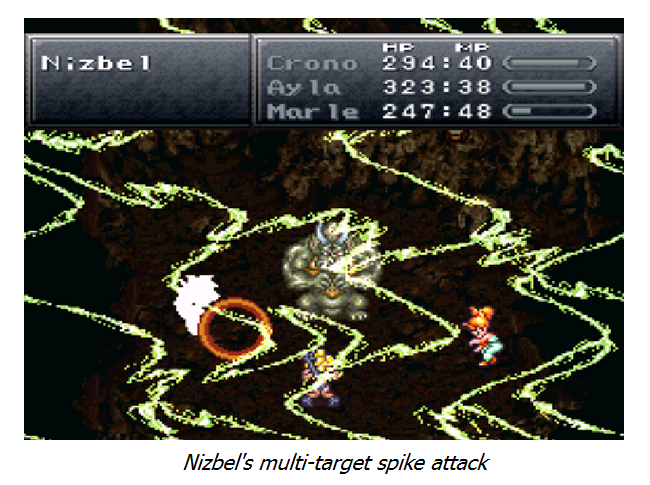
This is the spike that characterizes Nizbel as an attrition/spike boss like Yakra. Here we see the designers beginning to combine their design ideas to create greater challenges. For one thing, the spike hits the whole party. For another, the attrition/spike design calls for a dual-tech-and-heal strategy, but one party member (Crono) is going to be busy triggering that vulnerability! It�s not really that hard, but it does represent another step that the designers force the player to take.
One of the things that the player will have to explore is Chrono Trigger�s only real tactical element: party composition. Whereas in contemporary Final Fantasy games it hardly matters whom you bring (if you even have a choice) since many FF characters are blank slates, in Chrono Trigger member selection matters a great deal. That third character can swing the battle with Nizbel a bunch of different ways: Marle offers more healing, Robo and Lucca more power. Does the player burn Nizbel down fast, or live safely with lots of healing? This spot-check is important because the same kind of party composition play will play a big role in Magus� Castle.
Quest 8 - A Big Bad Bait and Switch
Stat of the Quest: Magus� Castle is unusual for its three-part structure; only 3 dungeons (15% of them) have three or more sections, while 40% have two sections and 45% have one section. One very brilliant quest has no dungeon sections at all. The point of this breakdown is to highlight yet another reason why the Magus� Castle section feels climactic, even though the designers are playing a trick on the player through the design.
Magus' Castle, in serving as the false climax of the first game, turns a lot of the established dungeon conventions on their ears, so to speak. And it ought to, since a normal two-part dungeon with one boss would be horribly anticlimactic. With or without the inherent deception, Magus� Castle is a really cool point in the game. Let�s get specific about why, though. Firstly, the dungeon, rather than ending with bosses begins with bosses--two of them in fact! Slash and Flea are no pushovers, and both serve as spot-checks, albeit for different things.
(1) Front section
To make sure that the party is actually ready to face these new, difficult bosses, the scant few enemies available in the first section of the castle are specifically tailored for grinding out some EXP and tech points. In the left-hand hallway there are two endlessly-respawning battles of four Decedents and one Omnicrone each. The reason they�re there is because they offer ten very easy, very quick tech points. These tech points are ostensibly for the purpose of Frog catching up to the rest of the party in learning techs, although they help anyone who�s lagging in abilities. On the right-hand side hallway, there are three respawning battles, each against more advanced enemies: two Henches, two Vamps and one Sorceror. It�s a more difficult battle, but it�s also double the tech points and offers about 1/7th of a level per battle.
Slash - Dual Tech and Heal... Again
Slash is a spot check for the omnibus Chrono Trigger strategy: dual-tech-and-heal, with emphasis on the healing component. He�s got a lot of HP and hits the party with a variety of attrition attacks. All that the player needs to do is heal frequently while maintaining damage output. To some degree, this makes it a good idea for the player to learn Frog�s Heal spell in the hallways before, because a lot of these small, frequent attrition attacks are multi-targeted.
Flea - Dealing with Status Debuffs
Flea is a little bit more complicated, although s/he has fewer HP to deplete. Flea serves as an introduction knowing when and how to cure status debuffs, although this skill won�t become useful until later. Flea can cause four status debuffs: poison, blind, sleep and confuse. Poison and blind are, in some sense, flawed implementations of regular design ideas. Blind only affects regular attacks--which the player isn�t often using--and when Flea uses poison attacks, s/he�s not using regular attacks, which means that the damage per turn is basically equivalent. Sleep and confuse, on the other hand, are really dangerous. Strangely, it will be a very long time (until the Black Omen) before status debuffs become a serious problem again.
(2) Middle Gauntlet
The middle section of Magus� Castle is the core of how this dungeon build towards a false climax. Ozzie has promised 100 monsters, and 61 of them come in this middle section. For an even greater effect, these monsters are strung out between some less combat-intensive challenges designed to add length and "breather levels" to the dungeon.
This section is dominated by three sequences of battles, punctuated by less-combat intensive challenges. The sequences of battles are essentially the same thing, three times: a long, plain hallway filled with encounters that get progressively more challenging. Many of those battles feature the Juggler enemy, who has a triggered vulnerability that switches back and forth from magic to physical damage every time that vulnerability is exploited. All of those battles serve as a challenge for party composition in support of multi-target dual techs. With six tough enemies on the screen at the same time (and this happens more than once!) it�s necessary to economize the number of turns spent killing them off. This means choosing the right party combination, of course, because not every party combination can use multi-target attacks at this point in the game (especially when two slots are limited to Chrono and Frog).
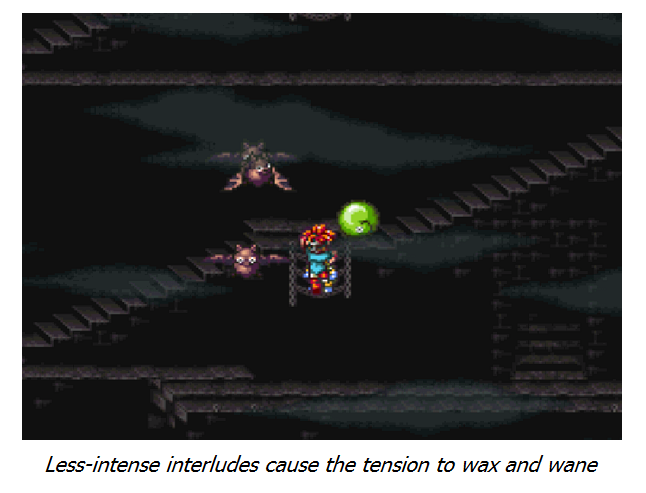
Breaking up these sequences are rooms with a number of different non-combat or low-combat challenges, designed to make the dungeon feel longer without overdoing it on combat. First there is a room that features non-battle damage and a conveyor belt; not that challenging because the damage isn�t terribly high, and there�s no resulting battle. The second room is a maze of trap doors. This one can be aggravating, but it would be considerably more aggravating if the player had to fight a battle every time he fell. That�s not the case--and falling one time actually yields some decent treasure and a save point. The third distraction is a set of two towers that put the player on a Donkey Kong style 2D background, forcing them to climb up and use ladders to avoid the �barrels,� which, in this case, are just rolling enemy encounters. It�s not hard to avoid encounters, and the battles aren�t hard either--certainly not like the sequences they break up.
At their worst, those challenges simmer at a low intensity, but they do a great job of making the dungeon seem a lot longer without becoming too tedious. Another neat trick of pacing by Chrono Trigger�s designers.
(3) The Big Boss
The fight with Ozzie is pure comic relief. It�s pitifully simple and easy, but it�s also a poignant design decision. By the end of the dungeon, the designers had these as reasonable options:
- No boss at all, straight to Magus - but can you really imagine going straight from the last sequence of battles into a tremendous boss fight that�s supposed to be the (false) climax of the game? Where�s the artistry in that?
- A tough boss battle - this would make Magus seem like he�s only half the challenge, much like Slash and Flea are two parts of the same challenge at the beginning. Plus, if Ozzie wears the players out, they won�t have the energy to enjoy Magus�s awesome battle/battle music as much.
- Another exploration section. That would pad the length and could help the player get mentally refreshed, but the purpose of these sections up until now has been to reduce tension, not build it.
- An easy, gimmicky boss battle - this simply breaks the tension up without lessening it, lets the players regroup, and focuses them on the real task: fighting Magus.
And so the designers chose wisely in setting up their big showdown.
Magus is the first example of a boss with sequential phases and the first real wipeout attack. The Heckran and the Guardian both had periodic phases where it was unwise to hit them, but one could be neutralized and the other could be avoided. In Magus� case, once he loses a certain amount of HP he will switch from wall-change and attrition attacks to one great big wipeout attack: Dark Matter. There�s an in-battle warning about its arrival, but it�s definitely the strongest attack the player will have seen, and can definitely wipe already-injured party members out. Even the Heckran and Guardian attacks, though abnormally powerful, were not quite this powerful. The design philosophy behind this attack is (1) make the battle feel climactic by killing unwary players the first time through and (2) introduce the unwitting player to the many wipeout attacks that will come in the rest of the game. They�re going to need to know to keep their party at full health more often!